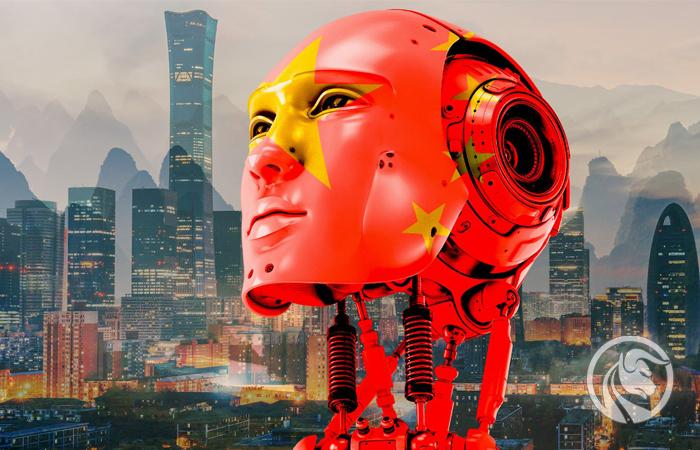China's Generative AI Challenges - Saxo Bank QXNUMX Forecast
China faces generative AI challenges in a world of global fragmentation. Breakthroughs in generative AI in the US, coupled with limited computing power and geopolitical tensions, threaten to break China's streak of success in applying new technologies, increasing productivity and growth.
China's strategic initiatives for the development of artificial intelligence
In May 2017, Google's AlphaGo stunned China by defeating Ke Jie, champion of China and world leader in the game of go, 3-0 thanks to the possibilities offered by artificial intelligence (AI). This triumph not only demonstrated the power of artificial intelligence, but also in some way initiated the intensification of Chinese activities for the development of AI technology.
In July 2017, China presented the "Next-Generation Artificial Intelligence Development Plan" and in December of the same year, the "Next-Generation Artificial Intelligence Three-Year Plan (2018-2020)". These strategic initiatives aimed to put China at the forefront of AI innovation, and were complemented in May 2020 by a "New Infrastructure Development Initiative."
China has used its mobile and internet economy, which includes huge amounts of data, to support artificial intelligence algorithms in understanding consumer preferences. Internet giants such as Baidu, Alibaba, Tencent and JD.COM have successfully used AI to identify market trends, deliver personalized products and services, and even anticipate customer needs in advance.
The challenge of generative AI
China has made significant progress in the application of AI, but generative AI requires technological sophistication and computing power to a whole new level. Over the past twenty years, Chinese enterprises eagerly relatively mature technology to modernize and transform the way we do commerce, retail, payment, entertainment and social media, from copying foreign business models to in-house developing business innovations that have started to set global trends. Nevertheless, this achievement was mainly about innovation in business models and the extension of AI applications to more and more aspects of everyday life.
As part of this process, thanks to the huge pool of data available in China, the speed and scope of this development has increased, and Chinese Internet companies have become corporate giants with a dominant domestic position and a global reach.
While China has led the way in some areas of AI, in particular visual recognition and AI-powered big data analytics, it is now facing a new challenge in generative AI, which represents a similar breakthrough to AlphaGo. Generative AI models such as belonging to OpenAI Chat GPT, have proven capable of generating consistent and contextually correct content, pushing the boundaries of what AI can do. This innovation shook the whole of China, motivating the Middle Kingdom to catch up.
In search of technological innovations and computing power
Chinese authorities are reportedly pressuring domestic Internet companies to develop more generative AI solutions and applications; these companies are fully aware that it is necessary prepare for groundbreaking changes as soon as possiblegenerative AI brings. The new challenges of generative AI, however, are linked to advances in technological innovation and massive computing power needs, and to a lesser extent to innovations in business models and new applications of mature technology.
According to Stanford University's 2023 Artificial Intelligence Index Report, China has moved closer to the United States in citations at AI conferences (China: 2023%; US: 22,02%) and citations from repositories (China: 23,86%; US: 20,98%); Despite this Middle Kingdom (at the level of 8,04%) still ranks much further down the linethan the US (at 54,02%) for citations of large language and multimodal models that are fundamental to generative AI such as ChatGPT.
The computing power challenge facing China is even more daunting given that computing power requires large number of advanced microprocessorsthat China cannot develop or produce. The situation was further aggravated by the US ban on the export of high-end semiconductors, as well as related equipment and technology to China, introduced in October last year, limiting the country's access to the necessary equipment enabling the rapid development of artificial intelligence, in particular generative.
Implications for the Chinese economy and investor perspectives
China aims to continue its success story of economic growth through technological innovation, new technology applications, business model innovation, productivity enhancement, economic growth and further technology investment. In a period of globalization, this series could continue even in the absence of certain critical technologies. However, as part of a game of fragmentation that is increasingly dominates the world stage, lagging behind in technological innovation can disrupt a series of successes and lead to a decline in productivity, ultimately hampering economic development.
Investors take this risk into account when considering investments in China, along with factors such as a slower-than-expected economic recovery and various types of constraints. These constraints include a highly leveraged economy, in particular with regard to local governments and the real estate sector, which somewhat reduces the ability of the Chinese authorities to implement appropriate stimulus in a way that does not create financial turmoil in the future.
The extent to which this situation will affect productivity in China's internet and manufacturing sectors and the broader economy, and how this will happen, remains a great mystery. Some investors positioning themselves for these changes are keeping a close eye on companies capable of developing generative AI applications, manufacturing AI-related devices, or manufacturing microprocessors, semiconductor materials, or AI-related hardware. Chinese companies popular with investors include Baidu, 360 Security, Lenovo, Shanghai Boasight Software, Iflytek, Unisplendour, ZTE and Foxconn Industrial Internet, which are listed on both mainland and Hong Kong stock exchanges.
While China's largest internet and tech companies are aware of the need to adapt their business models to potential disruptions, their generative AI products and new AI applications have yet to demonstrate that they offer promising prospects and a significant impact on their revenues.
Baidu has shown some progress thanks to an early focus on AI and the launch of ERNIE – an artificial intelligence model capable of searching, dialogue and content generation. Xiaomi continues to follow the development path of artificial intelligence and the Internet of Things (IoT), using deep learning to connect mobile devices and IoT. Tencent has developed its own AI models, including HunYuan and WeLM, to facilitate text generation, dialogue, translations and games.
Alibaba has created the M6 model (Multi-Modality to Multi-Modality Multitask Mega-transformer), while JD.COM developed pre-trained language models for understanding and generating natural language. Bytedance offers a multilingual machine translation model, while NetEase offers a YuYan language model.
All these initiatives are commendable, but they do not yet have a significant impact on the business models of these entities and much more innovative action is needed. While some of these companies are reasonably priced based on their current activities, they may represent interesting investment opportunities, but investors should note that high growth may be a thing of the past for these companies.
As technological innovation and productivity growth are key to success, companies developing smart manufacturing based on generative AI could be the next “new” to watch in China in the coming years. Investors can potentially benefit from following developments in this area.
Final remarks
China's drive to maintain its successful streak of economic growth based on technological innovation and productivity gains is essential. Investors assessing the potential of the Middle Kingdom should be aware of the challenges related to generative artificial intelligence, while noticing the potential investment prospects in companies ready to take advantage of these groundbreaking changes.
All Saxo Bank forecasts available here.
Redmond Wong, Market Strategist, Saxo Bank






















![Forex Club – Tax 9 – Settle tax on a foreign broker [Download the Application] Forex Club - Tax 9](https://forexclub.pl/wp-content/uploads/2024/02/Forex-Club-Podatek-9-184x120.jpg?v=1709046278)
![Trading View platform – solutions tailored to the needs of traders [Review] trading view review](https://forexclub.pl/wp-content/uploads/2024/03/trading-view-recenzja-184x120.jpg?v=1709558918)
![How to connect your FP Markets account to the Trading View platform [Guide] fp markets trading view](https://forexclub.pl/wp-content/uploads/2024/02/fp-markets-trading-view-184x120.jpg?v=1708677291)
![CRB index – one of the popular commodity market benchmarks [Guide] crb index](https://forexclub.pl/wp-content/uploads/2024/05/indeks-crb-184x120.jpg?v=1715055656)
![How to invest in ChatGPT and AI? Stocks and ETFs [Guide] how to invest in chatgpt and artificial intelligence](https://forexclub.pl/wp-content/uploads/2023/02/jak-inwestowac-w-chatgpt-i-sztuczna-inteligencje-184x120.jpg?v=1676364263)






![Izabela Górecka – “Success on the market depends not only on knowledge, but also on emotional stability” [Interview] Izabela Górecka - interview](https://forexclub.pl/wp-content/uploads/2024/04/Izabela-Gorecka-wywiad-184x120.jpg?v=1713870578)
![WeWork – the anatomy of the collapse of a company valued at $47 billion [WeWork, part II] wework bankruptcy story](https://forexclub.pl/wp-content/uploads/2024/04/wework-bankructwo-historia-184x120.jpg?v=1711729561)
![Adam Neumann – the man who screwed up Softbank [WeWork, part AND] adam neumann wework](https://forexclub.pl/wp-content/uploads/2024/04/adam-neumann-wework-184x120.jpg?v=1711728724)

![The most common mistakes of a beginner trader - Mr Yogi [VIDEO] Scalping - The most common mistakes of a beginner trader - VIDEO](https://forexclub.pl/wp-content/uploads/2024/03/Scalping-Najczestsze-bledy-poczatkujacego-tradera-VIDEO-184x120.jpg?v=1711601376)
![Learning patience: No position is also a position - Mr Yogi [VIDEO] Scalping - Learning patience - No position is also a position - VIDEO](https://forexclub.pl/wp-content/uploads/2024/03/Scalping-Nauka-cierpliwosci-Brak-pozycji-to-tez-pozycja-VIDEO-184x120.jpg?v=1710999249)
![When to exit a position and how to minimize losses - Mr Yogi [VIDEO] Scalping - When to exit a position and how to minimize losses - VIDEO](https://forexclub.pl/wp-content/uploads/2024/03/Scalping-Kiedy-wyjsc-z-pozycji-i-jak-minimalizowac-straty-VIDEO-184x120.jpg?v=1710336731)










